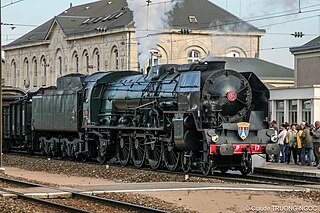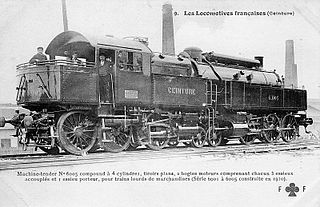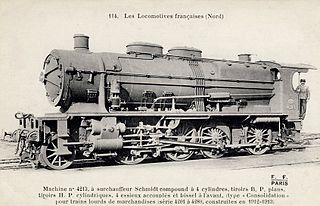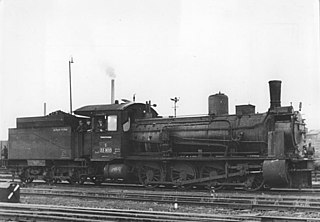
The SNCF 241.P is a 4-8-2 'Mountain' type express passenger steam locomotive that ran on the Société Nationale des Chemins de fer Français, from 1948 until 1973. Introduced as large scale electrification of the SNCF was already underway, they were the last new class of passenger steam locomotives in France.

État 42-001 to 42-020, was a class of 2-8-2 Tank locomotives of the Chemins de Fer de l'État.

État 140-101 to 140-370 is a class of 2-8-0 steam locomotive of the Chemins de fer de l'État, and subsequently the Société Nationale des Chemins de fer Français (SNCF).

État 231-500 to 231-783 was a series of 4-6-2 steam locomotives of the Chemin de fer de l'État.

Nord 3.1201 to 3.1290 was a class of 90 Pacific (4-6-2) type steam locomotive of the Chemins de Fer du Nord. They served in the north of France and Belgium. The first batch were built in 1923, and last remaining were retired from service in the 1960s. These locomotives were widely known as "Superpacifics" due to their high performance, which made them famous even in Britain.
Jean-Jacques Meyer (1805–1877) was a French engineer, noted for his work with steam engines and steam locomotives.

The du Bousquet locomotive was an unusual design of articulated steam locomotive invented by French locomotive designer Gaston du Bousquet. The design was a tank locomotive, carrying all its fuel and water on board the locomotive proper, and a compound locomotive. The boiler and superstructure were supported upon two swivelling trucks, in a manner similar to a Meyer locomotive.
The Chemin de Fer du Blanc-Argent (BA) is a 1,000 mm gauge railway in the Centre-Val de Loire region of France, part of which is still open to traffic, whilst another section is now operated as a heritage railway.

Nord 4.1201 to 4.1272 was a class of French Mikado tank locomotives built for suburban service on the Chemin de fer du Nord's lines that are north of Paris.
Nord 5.1201 to 5.1230 were a class of 2-10-0 “Decapod” steam locomotives of the Chemins de Fer du Nord, designed to handle heavy coal trains. On 1 January 1938, they all passed to the SNCF, who numbered them 2-150.B.1 to 30.

Nord 4.061 to 4.340 were a class of 2-8-0 tender goods locomotives of the Chemins de fer du Nord. At nationalisation on 1 January 1938 they all passed to the SNCF who renumbered them 2-140.A.1 to 2-140.A.280.

SNCF 232.P.1 was an experimental prototype high-pressure steam locomotive ordered by the Chemins de fer du Nord, but delivered to the Société nationale des chemins de fer français (SNCF) in 1939. It was the first and only member of SNCF's first class of 4-6-4 or Hudson type of locomotives.

SNCF 150.P were a class of 2-10-0 “Decapod” steam locomotives built as standard locomotives of the newly created Société Nationale des Chemins de fer Français (SNCF) between April 1940 and April 1950

Nord 3.1101 and 3.1102 were a class of two express passenger 4-6-4 (Baltic) tender locomotives designed by Gaston du Bousquet for the Chemins de Fer du Nord, and built in the company's La Chapelle Workshops.
Ceinture 81 to 93 were a class of thirteen 4-6-4T ("Baltic") tank locomotives designed by Gaston du Bousquet of the Chemins de fer du Nord for the Syndicat d'Exploitation des Chemins de fer de Ceinture de Paris.

Ceinture 21 to 35 were a class of fifteen French 0-6-0T locomotives of the Syndicat d'Exploitation des Chemins de fer de Ceinture de Paris. built in 1899 for pulling suburban passenger trains.
The SNCF 232.Q.1 was an experimental prototype steam locomotive of the Société nationale des chemins de fer français (SNCF) which entered service in 1940. It was Baltic or 4-6-4 locomotive.

The Class CC 14000 were electric locomotives operated by SNCF in France. They were one of four classes, together with the BB 12000, BB 13000 and CC 14100 classes, that formed an experimental group for studying the practicality of the new French 25 kV 50 Hz AC electrification. It was used in freight service along the Lille – Thionville line. They were nicknamed Fer à repasser.

Nord 2.311 to 2.380, were 4-4-0T locomotives for suburban passenger traffic of the Chemins de Fer du Nord. The machines were built in 1892–1893. They were nicknamed "Ravachol" because of the entry into service of the series when the latter was arrested in April 1892.

The Prussian G 7.2 was a class of 0-8-0 tender compound locomotives of the Prussian state railways. In the 1925 Deutschen Reichsbahn renumbering plan, the former Prussian locomotives produced from 1895 to 1911 were given the class designation 55.7–13; while the former Grand Duchy of Mecklenburg Friedrich-Franz Railway locomotives were classified as 55.57.















